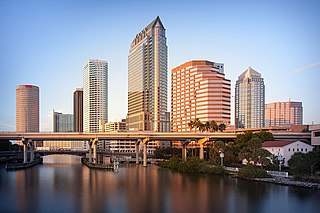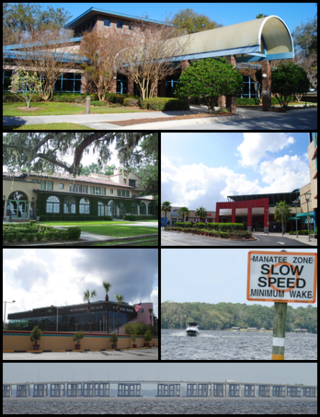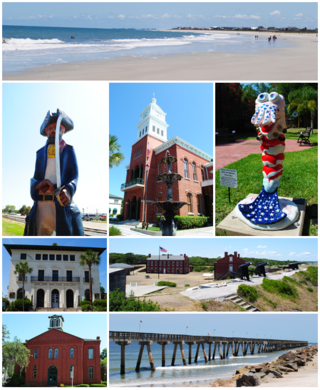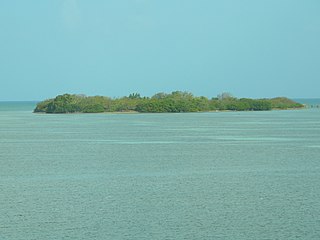This article needs additional citations for verification .(September 2018) |
Castor Town was a community in Hillsborough County, Florida, United States on Egmont Key and had 20 buildings in the early 1800s.
This article needs additional citations for verification .(September 2018) |
Castor Town was a community in Hillsborough County, Florida, United States on Egmont Key and had 20 buildings in the early 1800s.

Celebration is a master-planned community (MPC) and census-designated place (CDP) in Osceola County, Florida, United States. A suburb of Orlando, Celebration is located near Walt Disney World Resort and was originally developed by The Walt Disney Company. Its population was recorded as 11,178 in the 2020 census.

Boca Raton is a city in Palm Beach County, Florida, United States. The population was 97,422 in the 2020 census and it ranked as the 23rd-largest city in Florida in 2022. However, many people with a Boca Raton postal address live outside of municipal boundaries, such as in West Boca Raton. As a business center, the city also experiences significant daytime population increases. Boca Raton is 45 miles (72 km) north of Miami and is a principal city of the Miami metropolitan area, which had a population of 6,138,333 at the 2020 United States Census.

Alachua County is a county in the north central portion of the U.S. state of Florida. As of the 2020 census, the population was 278,468. The county seat is Gainesville, the home of the University of Florida since 1906, when the campus opened with 106 students.

The Seminole Wars were a series of three military conflicts between the United States and the Seminoles that took place in Florida between about 1816 and 1858. The Seminoles are a Native American nation which coalesced in northern Florida during the early 1700s, when the territory was still a Spanish colonial possession. Tensions grew between the Seminoles and settlers in the newly independent United States in the early 1800s, mainly because enslaved people regularly fled from Georgia into Spanish Florida, prompting slaveowners to conduct slave raids across the border. A series of cross-border skirmishes escalated into the First Seminole War in 1817, when American General Andrew Jackson led an incursion into the territory over Spanish objections. Jackson's forces destroyed several Seminole and Black Seminole towns, as well as the briefly occupied Pensacola before withdrawing in 1818. The U.S. and Spain soon negotiated the transfer of the territory with the Adams-Onis Treaty of 1819.

Tampa is a city on the Gulf Coast of the U.S. state of Florida. The city's borders include the north shore of Tampa Bay and the east shore of Old Tampa Bay. Tampa is the largest city in the Tampa Bay area and the county seat of Hillsborough County. With an estimated population of 403,364 in 2023, Tampa is the 49th-most populous city in the country and the third-most populous city in Florida after Jacksonville and Miami.

Davie is a town in Broward County, Florida, United States, approximately 24 miles (39 km) north of Miami. The town's population was 110,320 at the 2020 census, making it the largest town in Florida by population. Davie is a principal town of the Miami metropolitan area. Horseback riding is common, as much of its historic buildings include ranches and other Western establishments.

Orange Park is a town in Clay County, Florida, United States. As a suburb of Jacksonville in neighboring Duval County, it is formally a part of the Jacksonville, Florida Metropolitan Statistical Area. The population was 9,089 at the 2020 census, up from 8,412 from the 2010 census. The name "Orange Park" is additionally applied to a wider area of northern Clay County outside the town limits, covering such communities as Lakeside, Bellair-Meadowbrook Terrace and Oakleaf Plantation.

Lake City is a city in and the county seat of Columbia County, Florida, United States. As of the 2020 census, the city's population was 12,329, up from 12,046 at the 2010 census. It is the principal city of the Lake City Micropolitan Statistical Area, composed of Columbia County, as well as a principal city of the Gainesville—Lake City, Florida Combined Statistical Area. Lake City is 60 miles west of Jacksonville.

Key West is an island in the Straits of Florida, within the U.S. state of Florida. Together with all or parts of the separate islands of Dredgers Key, Fleming Key, Sunset Key, and the northern part of Stock Island, it constitutes the City of Key West.

Fernandina Beach is a city in northeastern Florida and the county seat of Nassau County, Florida, United States. It is the northernmost city on Florida's Atlantic coast, situated on Amelia Island, and is one of the municipalities comprising Greater Jacksonville. The area was first inhabited by the Timucuan Indian people. Known as the "Isle of 8 Flags", Amelia Island has had the flags of the following nations flown over it: France, Spain, Great Britain, Spain (again), the Republic of East Florida (1812), the Republic of the Floridas (1817), Mexico, the Confederate States of America, and the United States.

Jupiter is the northernmost town in Palm Beach County, Florida, United States. According to the 2020 US Census, the town had a population of 61,047. It is 84 miles north of Miami and 15 miles north of West Palm Beach. It was named the 9th Best Southern Beach Town to live in by Stacker Newsletter for 2022, was rated as the 12th Best Beach Town in the United States by WalletHub in 2018, and as the 9th Happiest Seaside Town in the United States by Coastal Living in 2012.

Palm Beach is an incorporated town in Palm Beach County, Florida, United States. Located on a barrier island in east-central Palm Beach County, the town is separated from West Palm Beach and Lake Worth Beach by the Intracoastal Waterway to its west and a small section of the Intracoastal Waterway and South Palm Beach to its south. It is part of the South Florida metropolitan area. As of the 2020 census, Palm Beach had a year-round population of 9,245.

East Florida was a colony of Great Britain from 1763 to 1783 and a province of the Spanish Empire from 1783 to 1821. The British gained control over Spanish Florida in 1763 as part of the Treaty of Paris that ended the Seven Years' War. Deciding that the colony was too large to administer as a single unit, British officials divided Florida into two colonies separated by the Apalachicola River; the colony of East Florida, with its capital located in St. Augustine and West Florida, with its capital located in Pensacola. East Florida was much larger and comprised the bulk of the former Spanish colony and most of the current state of Florida. It had also been the most populated region of Spanish Florida, but before control was transferred to Britain, most residents – including virtually everyone in St. Augustine – left the territory, with most migrating to Cuba.
A seaside resort is a city, town, village, or hotel that serves as a vacation resort and is located on a coast. Sometimes the concept includes an aspect of official accreditation based on the satisfaction of certain requirements, such as in the German Seebad. Where a beach is the primary focus for tourists, it may be called a beach resort.

Indian Key Historic State Park is an island within the Florida State Park system, located just a few hundred yards southeast of U.S. 1 within the Florida Keys. The island was home to the town of Indian Key, Florida in the middle of the 19th century but is now an uninhabited ghost town. It is frequently visited by tourists and is the subject of an archaeological project to uncover the historic building foundations.

Spanish Florida was the first major European land-claim and attempted settlement-area in northern America during the European Age of Discovery. La Florida formed part of the Captaincy General of Cuba, the Viceroyalty of New Spain, and the Spanish Empire during Spanish colonization of the Americas. While its boundaries were never clearly or formally defined, the territory was initially much larger than the present-day state of Florida, extending over much of what is now the southeastern United States, including all of present-day Florida plus portions of Georgia, South Carolina, North Carolina, Alabama, Mississippi, and the Florida Parishes of Louisiana. Spain based its claim to this vast area on several wide-ranging expeditions mounted during the 16th century. A number of missions, settlements, and small forts existed in the 16th and to a lesser extent in the 17th century; they were eventually abandoned due to pressure from the expanding English and French colonial settlements, the collapse of the native populations, and the general difficulty in becoming agriculturally or economically self-sufficient. By the 18th century, Spain's control over La Florida did not extend much beyond a handful of forts near St. Augustine, St. Marks, and Pensacola, all within the boundaries of present-day Florida.

Florida is a state in the Southeastern region of the United States. It borders the Gulf of Mexico to the west, Alabama to the northwest, Georgia to the north, the Atlantic Ocean to the east, and the Straits of Florida and Cuba to the south. About two-thirds of Florida occupies a peninsula between the Gulf of Mexico and the Atlantic Ocean. It has the longest coastline in the contiguous United States, spanning approximately 1,350 miles (2,170 km), not including its many barrier islands. It is the only state that borders both the Gulf of Mexico and the Atlantic Ocean. With a population of over 21 million, it is the third-most populous state in the United States and ranks eighth in population density as of 2020. Florida spans 65,758 square miles (170,310 km2), ranking 22nd in area among the states. The Miami metropolitan area, anchored by the cities of Miami, Fort Lauderdale, and West Palm Beach, is the state's largest metropolitan area, with a population of 6.138 million; the most populous city is Jacksonville. Florida's other major population centers include Tampa Bay, Orlando, Cape Coral, and the state capital of Tallahassee.
The Indigenous peoples of Florida lived in what is now known as Florida for more than 12,000 years before the time of first contact with Europeans. However, the indigenous Floridians living east of the Apalachicola River had largely died out by the early 18th century. Some Apalachees migrated to Louisiana, where their descendants now live; some were taken to Cuba and Mexico by the Spanish in the 18th century, and a few may have been absorbed into the Seminole and Miccosukee tribes.